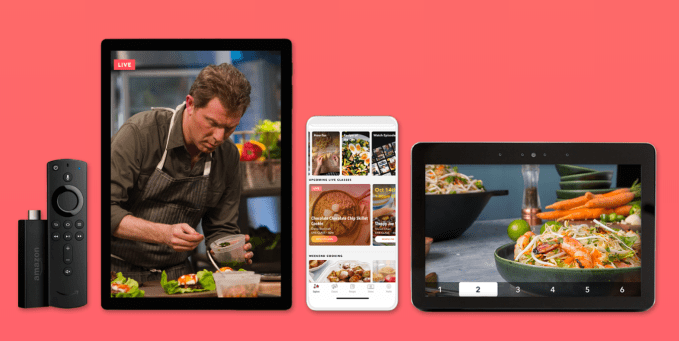Amazon is bringing a year’s worth of free, live and on-demand cooking classes to tens of millions of Amazon Fire TV and Fire tablet owners across the U.S., thanks to an expanded collaboration with Discovery’s Food Network Kitchen. The subscription service launched last fall as a flagship app for Amazon’s Alexa-powered Echo Show, bringing daily live classes, step-by-step cooking videos, on-demand video, home delivery of ingredients, and more to Echo devices owners.
While the Echo Show was the first smart-speaker-with-screen to gain access to Food Network Kitchen, the app is also available across devices, including Amazon’s Fire TV, Fire tablets, as well as iOS and Android phones and tablets.

The subscription offering combines episodes of popular Food Network Shows like “30 Minute Meals,” “Barefoot Contessa,” and “Brunch @ Bobby’s” with both live and on-demand cooking classes from culinary experts and top chefs, including Bobby Flay, Rachael Ray, Giada De Laurentiis, Guy Fieri, Martha Stewart, Alton Brown, Ina Garten, Andrew Zimmern, Ree Drummond, Daniel Boulud, Valerie Bertinelli, Sunny Anderson, Jonathan Waxman, Molly Yeh, Nancy Silverton, JJ Johnson and others.
In total, there are over 2,300 on-demand classes, hundreds of step-by-step videos, Food Network episodes, and over 80,000 recipes included in the subscription.
However, the live content is the service’s most compelling selling point, as it allows customers to cook with favorite chefs and then ask questions during the live Q&A portion of the show — essentially, it’s interactive TV.
Currently, Food Network Kitchen is selling for $4.99 per month or $39.99 per year, according to its website. (It launched with introductory pricing of $47.99 per year and $4 per month).
But starting today, Amazon will make the service available for free by offering Amazon device owners a one-year subscription to Food Network Kitchen.
The companies are hoping to capitalize on consumers’ increased interest in home cooking during quarantine, when restaurants are shut down and even takeout comes with a set of risks. With endless hours stuck at home, more people than ever are turning to cooking and baking to pass the time, then enjoying meals as a family. There’s no better time to reach this audience of home cooks with a service like this, the companies understand. And when the year is up, they believe many customers will continue to pay as they’ve experienced the value first-hand.
“When Food Network Kitchen came to Fire TV and Alexa last year, we saw how much customers love cooking with, and learning from, their favorite chefs,” said Marc Whitten, VP of Amazon Entertainment Devices and Services, in a statement about the subscription offer. “Many of us are spending more time cooking at home during these challenging times and are in need of a little inspiration. That’s why we are excited to offer all of our new and existing Fire TV and Fire Tablet customers a free year of access to Food Network Kitchen,” he added.
To coincide with the free subscription, Amazon and Discovery are also launching a “We Cook Together” initiative on May 2nd and 3rd, which will bring back-to-back live classes for two days straight, allowing Food Network Kitchen consumers to cook in real-time alongside their favorite chefs.
This feature will include 10 new cooking classes from thhe personal kitchens of Valerie Bertinelli, Scott Conant, Bobby Flay, Tyler Florence, Amanda Freitag, Alex Guarnaschelli, Marc Murphy, Michael Symon and Jet Tila
“During this unprecedented time, I know my first instinct as a chef is to turn to my kitchen, to cook something nourishing for those I care most about,” said Bobby Flay, about his participation in the live-streamed event. “Suddenly being faced with the task of cooking for yourself and family, multiple times a day, can be daunting, and we hope the Food Network Kitchen app and our #WeCookTogether weekend of live classes offer the assistance and motivation needed to plate something delicious for your loved ones,” he said.
Details on the offer are here.



